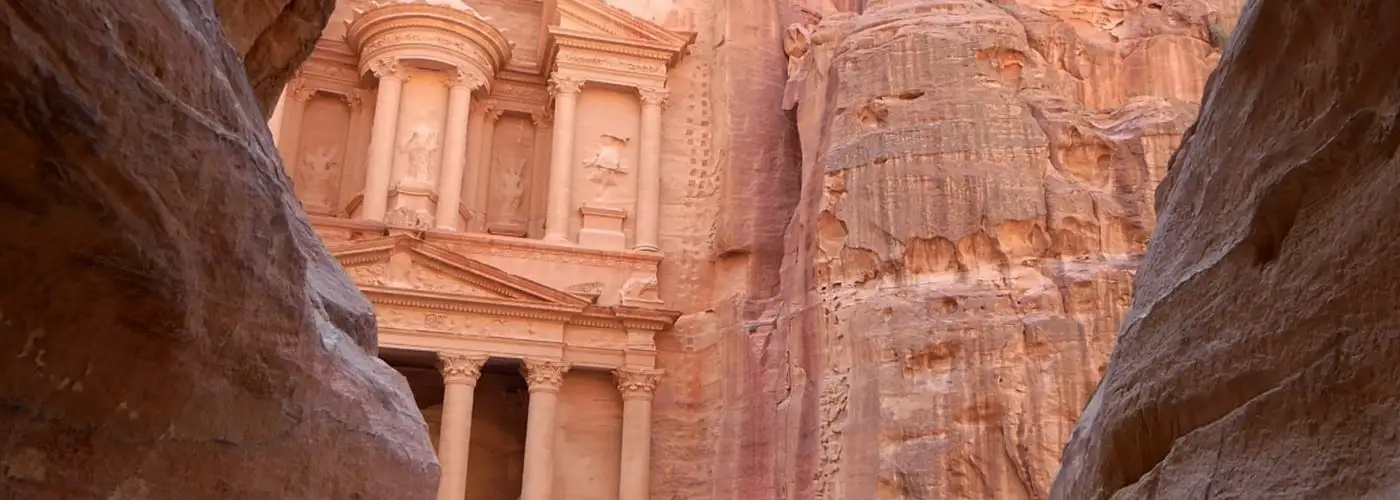One of the New Seven Wonders of the World, the Lost City of Petra hides coyly behind Southern Jordan’s pink sandstone cliffs. The rock-cut ruins of the lost Nabatean Kingdom feature Corinthian pillars, Hellenistic urns, and, in the case of the Treasury, classical relief sculptures fit for a king. The contrast between the jagged desert cliffs and the grand edifices that adorn them is as jarring as a crop circle perfectly etched into a field of corn.
And Petra’s origins are only somewhat less mysterious than a UFO incident. In a deep valley of the Petra Basin that’s barely discernable from the nearest highway, the most accessible route to Petra’s wonders is a mile-long chasm called the Siq. Navigating each blind turn of the narrow passage, I stopped wondering how this place could have been lost for a millennium.
Petra’s towering edifices were conjured from dust not once but twice. First in biblical times when the structures were hand-carved from the walls of the desert basin, and again in 1812. Thought to have been nothing more than a myth, they were rediscovered after lying empty for 11 centuries.
Visiting Petra, Jordan’s Lost City
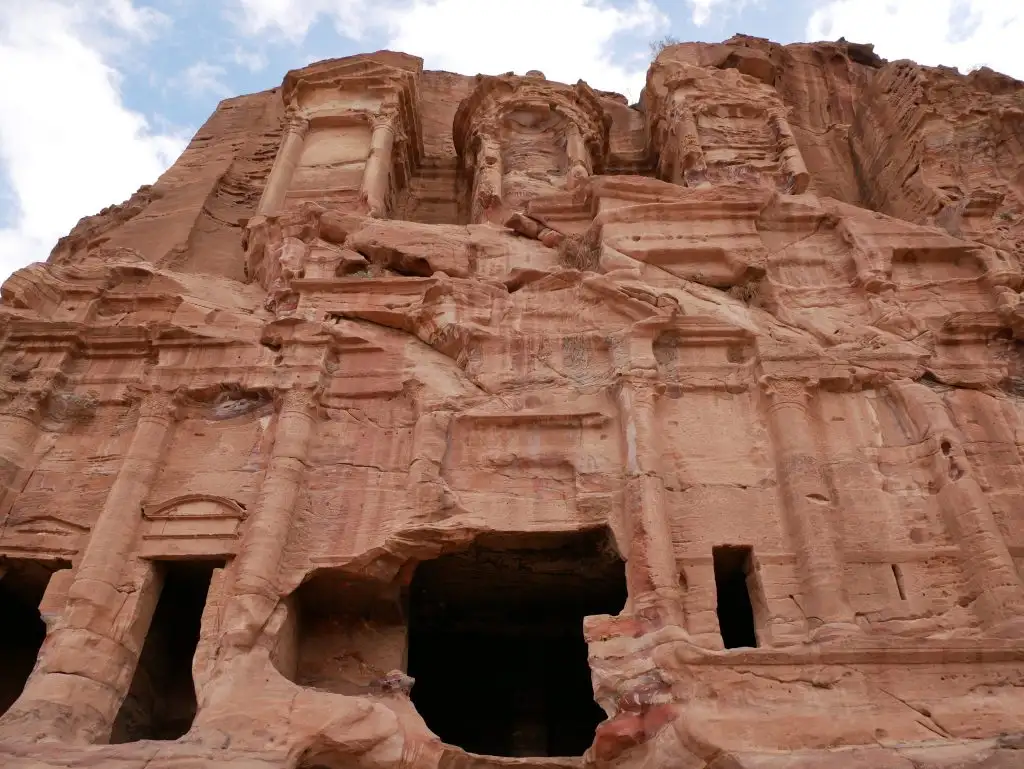
A once-bustling trading hub with a king and thousands of inhabitants, Petra was built around the first century B.C., though no one knows the exact dates of construction. The city is thought to have been “lost” thanks to Roman annexation around 100 A.D. and gradual abandonment after an earthquake struck around 300 A.D.
Bedouins, the nomadic tribespeople of the area, are thought to have known the location of Petra during its lost years, but may have hidden it in an effort to protect treasures thought to be hidden in the kingdom’s most ornate tomb—now dubbed The Treasury, for that reason.
An enigma even today, the city itself is still being uncovered: Experts say the ancient ruins that attract thousands of travelers per day only make up 15 percent of the capital of Nabatea. The rest likely remains underground, silted over by centuries of desert sand.
So it might not surprise you that visiting Petra, one of the most complex and awe-inspiring wonders of the world, is no small feat. Here’s what to know before you go, and what I learned from spending two days in Petra with an expert guide.
Go with a Guide
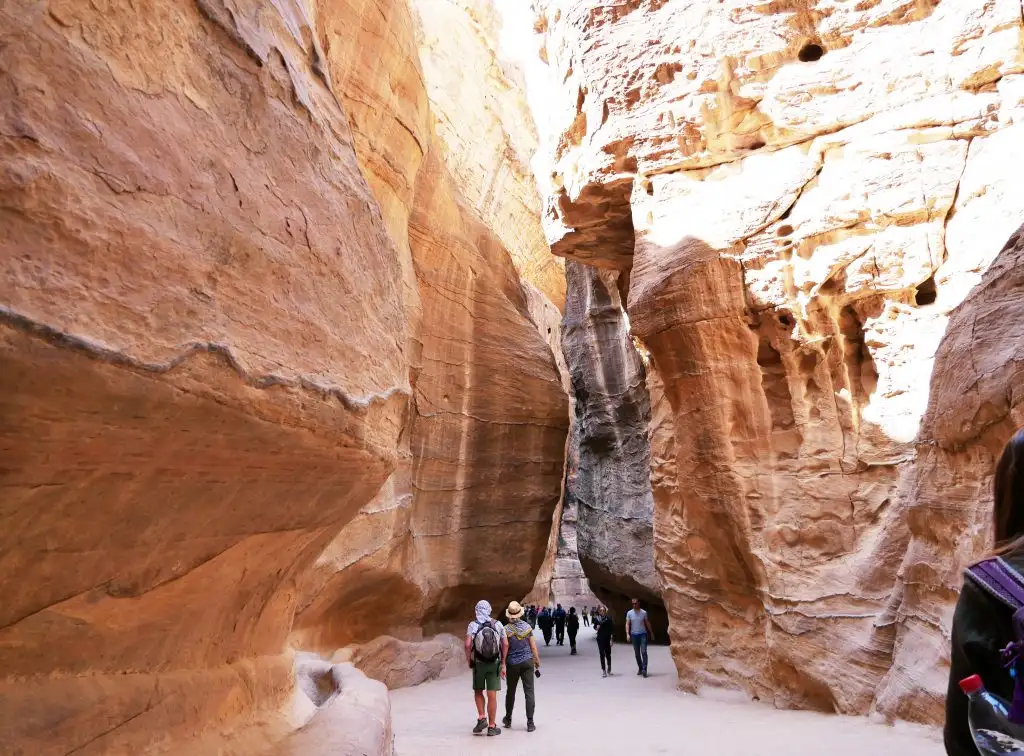
If you stop reading right now, the one thing you should know about Petra is that it’s a little-regulated tourist site and complex World Wonder that’s almost impossible to see correctly without an expert local guide. Petra has travel scams and dangers to look out for, but also plenty of hidden historical gems and incredible views to uncover—and you’re extremely unlikely to find them, or to experience them the right way, if you’re visiting Petra on your own.
Local guides like Intrepid Travel‘s are experts on the ancient Lost City of Petra, and some of Petra’s best hikes come pre-planned into the travel company’s eight-day Trek Jordan itinerary. If you’re looking for a smaller commitment, Intrepid also offers a three-day Petra trip with a stop at the Dead Sea, or the Petra Authority has licensed guides on site who can take you on a last-minute tour if you ask at the entrance.
In general, it’s easy to find a top-notch private local guide when visiting Petra or anywhere else in Jordan: Expert guides can show you a Jordan Tour Guides Association identification card that proves they’re the real deal.
Pace Yourself
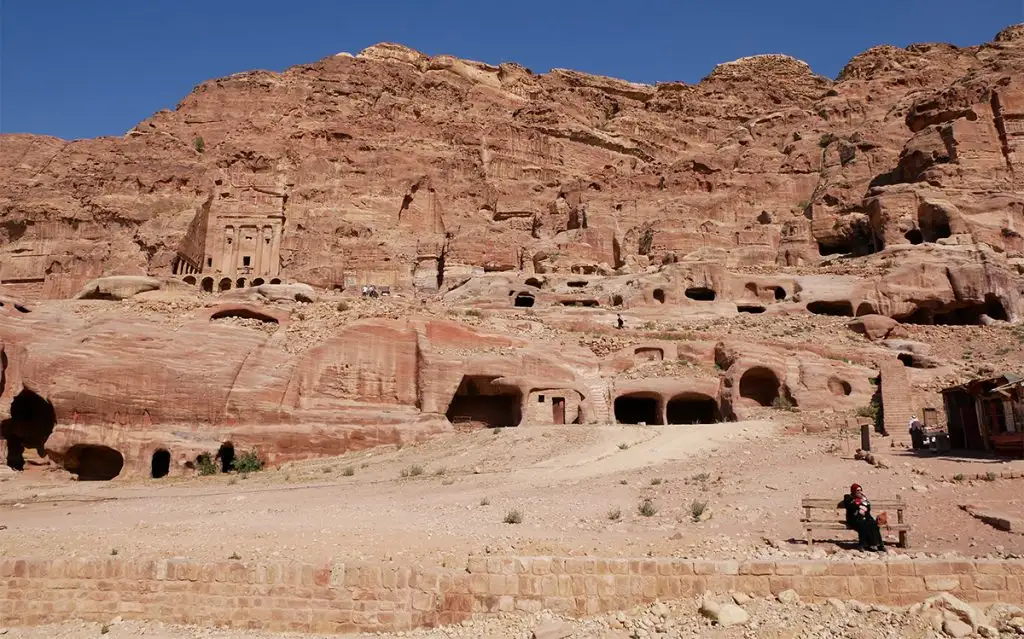
You’ll need a whole day to see Petra’s best views and ruins, and two if you want to experience the hidden gems on lengthier hikes. The 2,000-year-old Nabatean ruins include an amphitheater, courthouse, monastery, and many homes and mausoleums. Little Petra, a smaller settlement of Nabatean ruins about six miles from the main attraction, is also a must-visit Petra experience for its recently uncovered ancient cave paintings, irrigation networks, and caves perched high in the cliffs—which you can enter via stone-carved staircases.
Avoid the ‘Jack Sparrows’
One of the most complex and underreported travel scams I’ve ever encountered, Petra’s “Jack Sparrows” at first seem like a novelty of the tourist site. But, the pirate-looking men can be a uniquely menacing travel scam to avoid when visiting Petra.
Referred to as such by the locals, Jack Sparrows are young men who, in addition to wearing traditional glare-reducing eye liner called kohl, seem to play off the Pirates of the Caribbean character by invoking his clothes and swagger. They perform dangerous tricks on horseback in an effort to get tips, and offer to bring visitors to spots like a secret viewpoint overlooking the Treasury. The problem? They’re known to take tourists up dangerous, illegal routes off the main paths. And even worse than getting you lost or injured for a fee, some female visitors have also warned of Jack Sparrows who operate “love scams” that involve flattering women in an attempt to solicit money for sex.
The most troubling part of this scam is that it capitalizes on the genuine Bedouin tradition of hospitality that you’ll encounter in and around Petra. Jordanians are apt to offer up tea and stories, and ask if you need any help or directions. All the locals I talked to as a female solo traveler in Jordan were helpful and gregariously friendly. The Jack Sparrows, though, were a different story. My guide and others had some troubling stories about them, and their novelty quickly wore off.
Petra’s Development and Tourism Region Authority tells me they’ve prosecuted Jack Sparrows for crimes, and are working to better warn tourists about them.
“The PDTRA has signage that tells tourists to take only officials tour guides and not to climb risky areas,” PDTRA commissioner Suleiman Farajat tells me. “However, the unofficial encounter seems to have increased recently … We receive complaints on this matter and are aware that this kind of behavior should be controlled.”
Uncover the Monastery
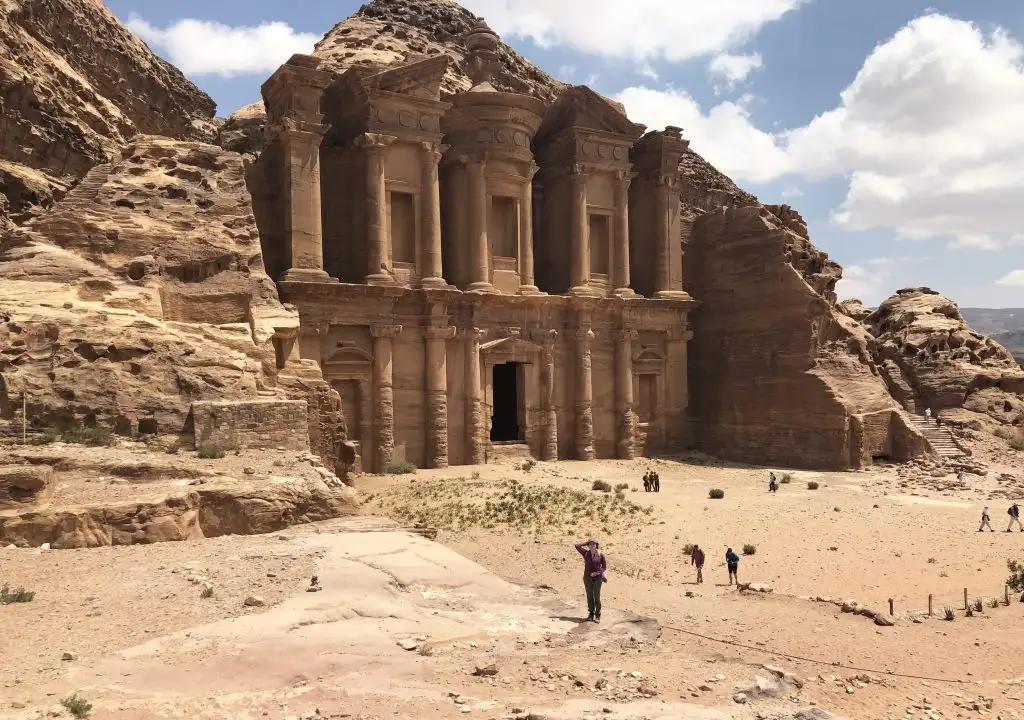
One of Petra’s grandest wonders is also one of its most difficult to reach. Accessible from central Petra via an hour’s-worth of stairs (850 steps, to be exact), the Monastery is noticeably larger than the Treasury, at 150 feet high.
Tour guides like Intrepid Travel’s also take groups to the Monastery through a rear desert route that starts at Little Petra, six miles away, which means taking the Monastery route’s stairs downward into central Petra. No matter what route you choose, though, the Monastery is undeniably worth the effort of the climb. Just watch out for the occasional donkey toting visitors up the paths.
Don’t Ride the Animals
Visiting Petra is an exhilarating, tiring experience, so it might be tempting to accept one of the numerous offers you’ll field for a horse ride down the Siq or up to a precarious view point. However, you should think twice before you accept the ride, which is included in your ticket price—mainly because the treatment and use of work animals at Petra is a hotly debated topic.
It’s clear that many of the work animals used at Petra are unhealthy and overworked. As long as visitors keep accepting rides on them, though, they remain a valuable means for the locals who own and employ the horses and donkeys to make a living. It’s largely up to visitors to ease the use of work animals at Petra by ebbing the demand for them until the local government steps in.
“We are working on policies regarding all working animals in Petra including the siq,” Farajat, of the Petra Authority, tells me. “We possibly will introduce club cars instead of the horse carriages inside the and will define trails for camels and donkeys inside the park.”
See Petra by Night
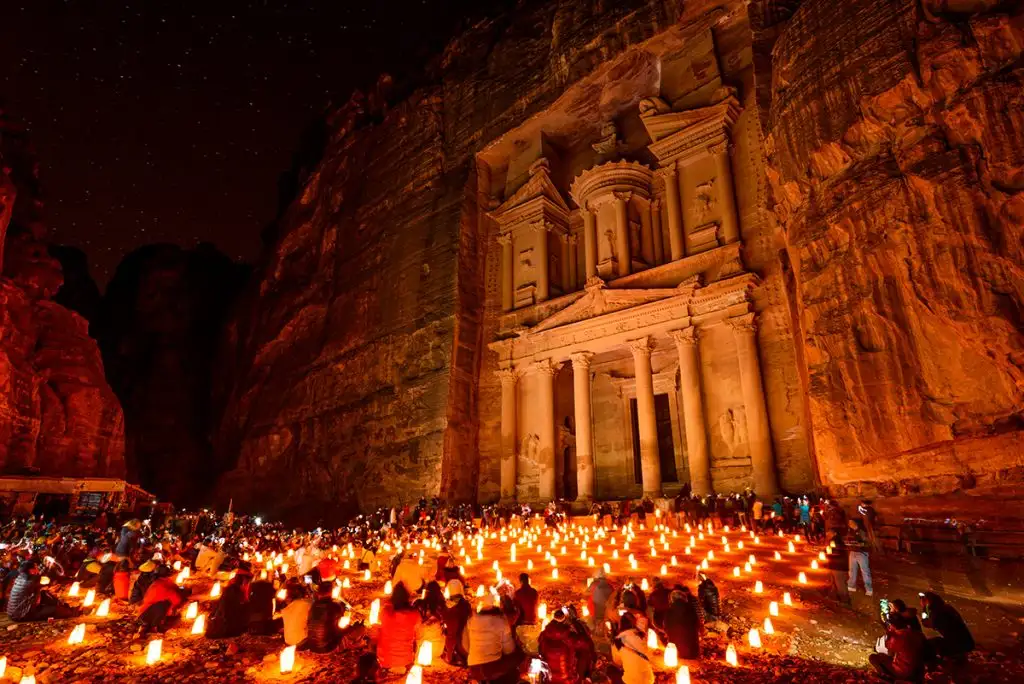
A more appropriate way to directly benefit the locals than by accepting offers for animal rides is by visiting Petra by Night, a show put on by local Bedouins at the Treasury. For a reasonable fee you’ll be able to navigate an ambient Siq at sunset and witness a musical performance beneath the Treasury and under the glow of hundreds of candles. The Petra basin’s most-detailed edifice is doubly majestic at night, when it’s crowd-free and softened by candlelit shadows.
Tickets are available at entry the day of your visit (and only in addition to a standard daytime pass) for about $25. For some downtime between your day-long trek and a Petra by Night show, the Cave Bar at Petra’s main entrance is an equally ambient (albeit pricey) spot to rest your feet and enjoy dinner and/or a drink before heading back into the site.
Choose a (Very) Nearby Hotel
After a full day (or two) of exploring Petra, retiring to your hotel should require minimal effort. Petra is a protected area, but it’s no stranger to high-end hotels: there are two at the site’s main entrance. Just across the street, the Movenpick Resort Petra beckons with a pool and ornately decorated patios perfect for enjoying tea. If that walk across the road is too far, the Petra Guest House sits right beside the site’s main gate, so close you can see some ruins from the property.
More from SmarterTravel:
- 9 Epic Hiking Trails to Tackle Before You Die
- Editors’ Choice: 10 Best Up-and-Coming Destinations
- 10 Unexpectedly Affordable Vacations to Take in 2018
SmarterTravel Editor Shannon McMahon visited Jordan as a guest of Intrepid Travel. Follow her on Instagram at @shanmcmahon for Jordan travel insight and more.
We hand-pick everything we recommend and select items through testing and reviews. Some products are sent to us free of charge with no incentive to offer a favorable review. We offer our unbiased opinions and do not accept compensation to review products. All items are in stock and prices are accurate at the time of publication. If you buy something through our links, we may earn a commission.
Related
Top Fares From
Today's Top Travel Deals
Brought to you by ShermansTravel
Kenya: 14-Night Tour, Incl. Tanzania &...
smarTours
 vacation
$7125+
vacation
$7125+
7-Night Caribbean Round-Trip Cruise From Orlando:...
Norwegian Cruise Line
 cruise
$739+
cruise
$739+
Ohio: Daily Car Rentals from Cincinnati
85OFF.com
 Car Rental
$19+
Car Rental
$19+
